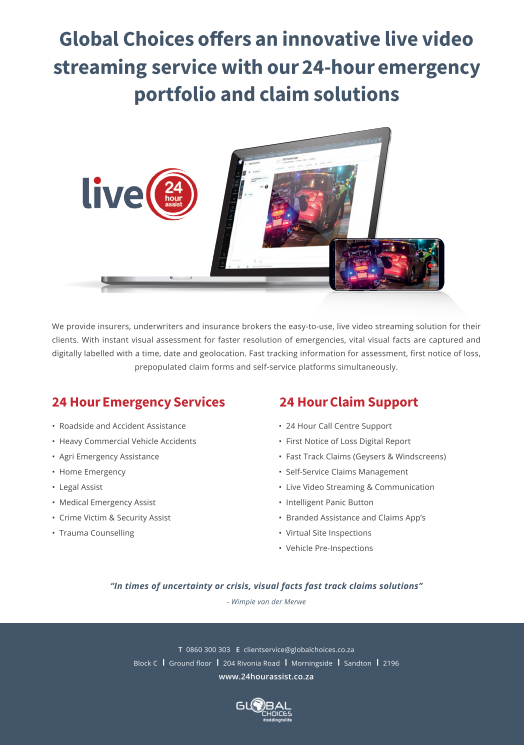Wimpie Van Der Merwe (CEO, Global Choices)

Insurers are quickly entering a new era of claims management thanks to the pandemic, which caused accelerated advancements, a wave of innovation and investment that affected employees and customers alike. This new era is supported by rapid technological advancements and growing data availability. Insurers have had to accelerate their adoption of next-generation capabilities in digital engagement, automation, AI, and advanced analytics.
These new improvements and innovations provide unprecedented visibility into the claims process, the shifting preferences of customers, and the expectations of a new age of employees who are requesting a digital experience. Every touchpoint in the claims journey, starting even before an incident occurs, will be supported by a mix of technology and human contribution that seamlessly expedites the process.
Focus is on a single customer view and digital personalisation
A single customer view platform is a method for gathering all the data about your policyholder/customer and merging it into a single digital record.
By consolidating every piece of information about your policyholders in one location, you get a powerful overview of every action they performed – on their mobiles, or on your website. This core platform enables API-driven, smart services, digital architecture to support analytics models, digital self-service portals and collaboration with other Insurtechs. This will assist with automation across the claims business and enable efficiency and indemnity benefits. Digital personalisation capabilities are the new competitive edge when it comes to acquiring new clients, managing claims, and retaining customers.
Customers understand that digital communication means that their insurer collects their personal data – anything from behavioural data to their location or any information they have submitted. They expect an insurer to use this information to improve and personalise their experiences across the whole insurance journey and value chain.
They don’t look at every single interaction with their insurer in isolation. They treat any communication or interaction, no matter the channel, as a part of the whole. So, focus on a holistic view of your claims operating models and how they fit into the overall business strategy and total experience.
Experience is and will continue to be everything. This requires a total experience strategy to optimise multiple objectives at every touch point.
A total experience strategy
Total experience (TX) is a strategy that creates superior shared experiences, by combining the four disciplines of multi experience (MX), customer experience (CX), employee experience (EX) and user experience (UX).
It focuses on the customer relationship and is made up of all the interactions a customer has had with a business, from the first contact with the company to the present day.
It is about improving experiences at all the intersections of multiple touchpoints to achieve an innovative commercial outcome. A TX strategy incorporates the complete experience, from the employee to the customer and the user. The total experience consists of more than just taking care of customers – it is about providing an outstanding environment or platform for employees to provide an excellent client service experience.
Reinvent the role
The future claims facilitator will be at the centre of a service offering, channeled through customers’ preferred means of interaction and powered by real-time access to relevant data and information. He or she, equipped with effective digital claim tools and with the support of a strong back-office, will bring claims to a faster and more satisfactory resolution for both the policyholder and the insurer.
The claims professional of the future must also be less focused on processing and more oriented on decision making, assisted by access to intelligent data and protocols. Changes in the claims operating model and the roles of who processes what will require a new set of thinking and measurement to ensure that performance objectives are aligned. In essence, today’s common claims metrics, focusing primarily on “inventory” such as file counts, closure rates and average pending, are becoming increasingly less relevant in a world where a claim may be touched by several people, each with specific responsibility and contribution to the ultimate outcome.
These traditional measures will need to give way to a balanced scorecard or automated measures that are reflective of everyone’s impact and efficiency on the claim’s outcome.
Data-driven claims to fast track cycles
The speed, efficiency and transparency in the claims process depend on the insurer’s ability to capitalise on rich claims information, make it readily available to internal and external users, and leverage it for continuous improvement. Next to the new business and underwriting process, the claims transaction is where insurers learn the most about their individual policyholders and, in the aggregate, about their businesses. This wealth of information creates new opportunities for insurers to not only improve the efficiency and effectiveness of the claims process itself but also to improve their underwriting, pricing, risk selection and reserving.
Breaking away from the pack should not be a question of tactical steps. A true claims transformation will deeply and unbreakably connect products and claim services with the needs of customers.
Perfecting the customer’s claims experience
Total experience extends beyond perfecting the customer’s claim experience. It is about your employee and user experience, and how this will impact the policyholder claims journey you offer.
Smart claim functions of the future will need to be powered by technology, data, and people as a total experience. Claims are the moment of truth for insurers – it is where they are tested in terms of their ability to delight or disappoint clients. It’s time to get smarter!


